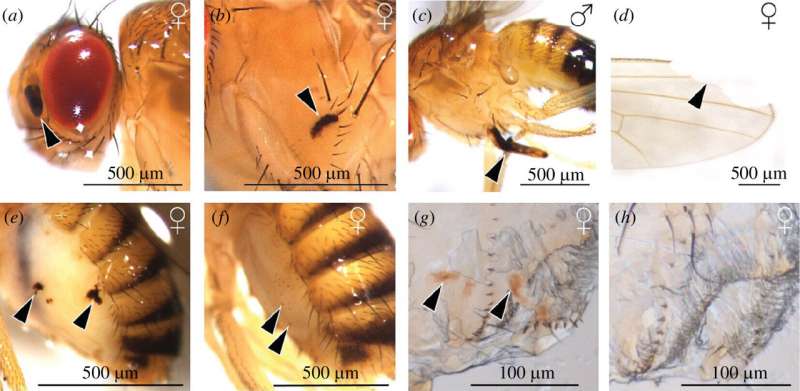
A small team of biologists from Freie Universität Berlin and the Max Planck Institute for Chemical Ecology, both in Germany, has calculated the degree of risk faced by wild fruit flies by capturing more than 10,000 of them and studying their bodies to see if they had any physical injuries.
In their study, published in the journal Royal Society Open Science, the group found that the high percentage of injuries in fruit flies could have played a role in the way that their immune system has evolved.
Prior research and anecdotal evidence have suggested that large numbers of flying insects are killed rather than die naturally. What is less well known is how many of them are injured and go on living their lives.
The research team suggests that better understanding injuries in insects could help to better understand how the immune system evolves in general. This is because whenever an insect is injured, the immune system responds to prevent the injury from becoming infected.
In this new study, the team focused their efforts on fruit flies because it is relatively easy to capture large numbers of them. To that end, they set fruit fly traps at three farm locations over a three-season span in 2021 and collected more than 10,000 of the insects, which they brought back to their lab for study.
The researchers looked at each fly under a microscope, counting signs of injuries or wounds, including damage to body parts, missing limbs and dark patches of melanin that are the fruit fly equivalent of a scar.
The researchers found that approximately a third of the flies had signs of injury to some part of their body, including wings. They also found that the flies were injured in a wide variety of ways, including being bitten, smacked and damaged by parasitic mites.
They also found that females were approximately four times as likely as males to experience an injury to their abdomens, though it was not clear why. Some of them were likely due to mating injuries. Males also had a lot of injuries that appeared to have come from fighting with other males.
The research team suggests that such a high rate of injury most certainly has played a role in the evolution of the fly immune system—the fact that so many were able to carry on with their lives after sustaining serious injuries, they suggest, is a testament to the effectiveness of their immune systems.
More information:
Bengisu S. Subasi et al, How frequently are insects wounded in the wild? A case study using Drosophila melanogaster, Royal Society Open Science (2024). DOI: 10.1098/rsos.240256
© 2024 Science X Network
Citation:
Calculating injury risk for fruit flies by counting wounds in the wild (2024, June 26)
retrieved 26 June 2024
from https://phys.org/news/2024-06-injury-fruit-flies-wounds-wild.html
This document is subject to copyright. Apart from any fair dealing for the purpose of private study or research, no
part may be reproduced without the written permission. The content is provided for information purposes only.




